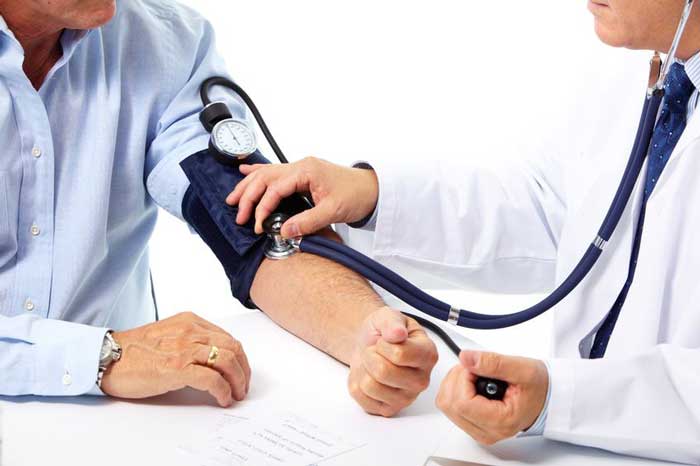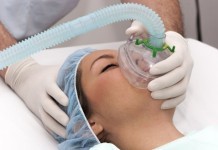In this series, we review the physical exam, the intermediate step in a patient evaluation that ultimately leads to imaging. There are so many means by which to evaluate a patient, the best of which involve not laying a single hand on the patient at all. Unfortunately, the physical exam is becoming a lost art form. With these tips on the physical exam, starting with the heart, we will do our part to ensure it stays that way.
 Examination of the cardiovascular system can be broken down into five parts: observation, palpation, auscultation, confusion, and consultation.
Examination of the cardiovascular system can be broken down into five parts: observation, palpation, auscultation, confusion, and consultation.
Observation
Before laying hands on the patient, be sure to observe the patient’s blood pressure. Don’t take it yourself, just observe it as documented on the chart or computer. Rely on someone else to measure the blood pressure with an inappropriately sized cuff. Never do a manual blood pressure, as this requires effort. This will ensure the most mediocre results.
One of the most difficult skills to master is the assessment of jugular venous distension or JVD (just very difficult). So don’t bother. Skip this step.
However, if you insist on assessing JVD, you must know your anatomy: the right internal jugular vein is somewhere above the waist, possibly in the neck. Next, you must remember your waveform: P wave, QRS complex, and T wave. If you see ST elevations in the jugular venous waveform, call cardiology immediately.
Next, you want to observe the heart directly. Perform a sternotomy and expose the heart. Observe it. Amazing how much it jiggles, right?
Palpation
Using cold hands recently dipped into a bucket of ice, place your right hand just below the patient’s left nipple. Observe the nipple shriveling up: how small is the nipple? is it pinpoint? Now palpate: is it hard enough to cut glass? how about diamond? By palpating in this manner, you will distract yourself from remembering how to locate the point of maximal impulse or PMI (pretty much impossible).
Next, assess the carotid arteries by palpating a keyboard and ordering “carotid ultrasound.”
Auscultation
Ask your patient to put on a turtleneck sweater and jacket over their gown. Stethoscopes are incredibly powerful, so make it a challenge with some extra barriers in between. Location doesn’t matter either, just drop the stethoscope anywhere. Bell, diaphragm, sternum, chest, whatever. Now going from side to side while having the patient take deep breaths…
No wait, that’s the lung exam.
First, identify normal heart sounds: S1 and S2. If no luck with S1 and S2, try L1 and L2 or R1 and R2. If no success there, try to hear A, B, Select, or Start. Next, identify abnormal heart sounds: wheezes, rales, or rhonchi…
Damn it, that’s the lung exam again.
Murmurs are suggestive of valvular disease so pay attention: is the murmur occurring during diastole or systole? is it soft, loud, shy, or offensive? how does the murmur rate on a Yelp scale from 1 to 5 stars, where 1 is “Eek, methinks not” or “Woohoo, as good as it gets!” The most common type of murmurs are audible ones, followed by ones seen on echocardiogram. The Austin Flint murmur is a less common murmur named after Austin Flint, the one person who has ever heard it.
Gallops may represent pathology in older patients. When you hear an S3 or S4 gallop, step back and make sure you’re not anywhere near a racetrack like Preakness or Belmont. As the old adage goes, Whenever you hear hoofbeats, always think horses. How embarrassing would it be to hear a murmur when it turns out you were just examining a thoroughbred?
Lastly, take a deep breath, close your eyes, and auscultate a troponin level.
Confusion
Now that you’ve observed, palpated, and auscultated the patient’s heart, you are most likely highly confused as to the diagnosis. Great job! That’s exactly how you should feel after a heart exam. Way to not be a gunner!
Consultation
Now that you’ve confirmed your insecurities in performing a heart exam, consult cardiology. Cardiologists are extremely helpful; it’s as if they’ve dedicated their whole careers to the heart and heart alone. Once they’ve heard about your patient, they’ll ask if you performed the most important physical exam maneuver of them all: the ECG. Don’t forget to perform it!
Man, those guys are smart!
More Physical Exam Tips below:
– The Lungs
– The Abdomen
– The Eye
– The Nervous System







